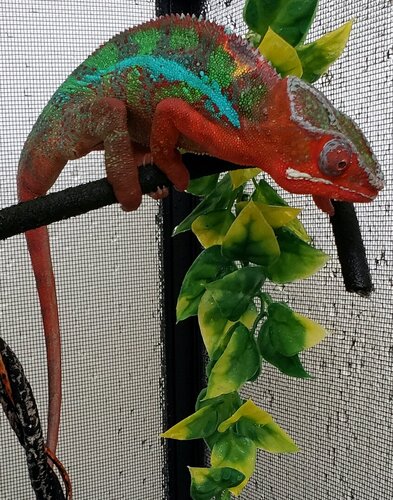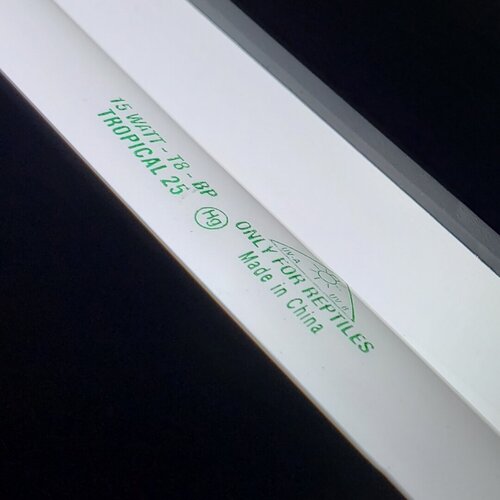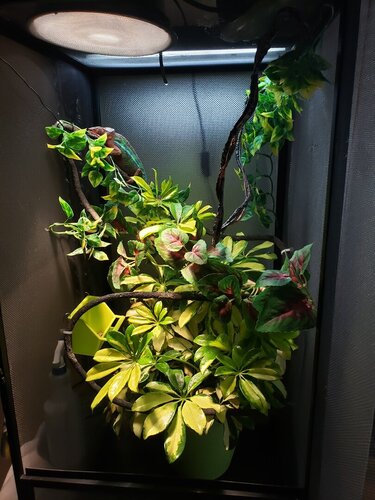RescueMom
Avid Member
I'm not new, but I have a new little one and I'm looking for some insite
Chameleon Info: Male Panther, almost, 9mos old. I've had him a little over 3 weeks
Handling - maybe every other day or so, sometimes because he climbing out when I'm trying to put his feeders in ?
Feeding - I feed him in first part of the day and remove feeders he hasn't eaten by early afternoon. He ate a few crickets, but lost interest. He will eat super worms, but likes to have the dish held for him while he eats, so that's a bit of a pain. He LOVES wax worms, and black soldier fly larva. He is TERRIFIED of horn worms (weirdo?) and showed interest in butterworms, but hasn't tried one yet.
Gut-loading superworms and crickets with Flukers cricket quencher.
Supplements - Dusting with repashey calcium plus daily and zoo med calcium with D3 once every 2 weeks
Watering - he has a monsoon mini mister on a timer. It is scheduled to go off 3 times a day, 4 hours apart for 30 seconds. He also has a dripper that he sits under, letting the water drip on his head, then he drinks the water when it runs off. He does regularly drink water from the leaves, especially first thing in the morning. I use tap water with Prime water conditioner in both the mister and the dripper. I also have a smaller reptibreeze set up for him to get extra hydration weekly in the shower.
Fecal Description - his latest (which was this morning) was a cream color urate, followed by a dark reddish color (which also seemed to be urate), then a normal looking feces (no undigested feeders or anything odd). I've not had him tested for parasites
History - I got him from someone who was rehoming him due to her having an adult male Panther that needed more attention than she had for both of them
Cage Info:
Cage Type - 24x24x48h screen reptibreeze. The back and one of the sides has a hard plastic panel (my design) on the outside to help with humidity level and temperature in the cage
Lighting - Strip lighting with Exo Terra tropical 25" 15w T8 reptile bulb Flukers sun dome reptile lamp with ZooMed 100w daylight heat bulb. Lights are on a timer. On for 12 hours. Off for 12 hours. 7:30am-7:30pm /on
Temperature - basking temperature in the upper 80s. To measure the basking temp, I have a Zoo Med digital thermometer in the cage that is positioned on the branch at the point highest for him. Ambient temperatures range from 69 to 75, which is based on the thermostat in the house Florida "winters" make for difficult temperature regulating. Nights temps are no lower than 67, but no warmer than 75. Humidity - I haven't checked humidity levels, but in Florida creating humidity is never a problem. However, I do have 2 sides of his cage enclosed on the outside rather than all open to help keep more humidity in.
Plants - I have one live plant in his cage now, a shefflera. Placement - The cage is in a spare bedroom. No traffic. No fans. The to top the cage is approximately 5ft off the floor Location - Florida
Current Problem - when I got him 3 1/2 weeks ago he looked like he was about to shed, but he's still the same. The bottom half of his tail has finished shedding, but that's it.
Also, he started closing his right eye late in the evening and that eye has gradually gotten less "hydrated" looking that his left eye. He seems to be able to see fine with both eyes, and they look clear, but the right eye getting less bulgy looking is concerning.
There is also a really strange spot on his back, to the right of his spine. It looks almost black like a burn, but I can't see how that could be. The dark spot has yellow around it, which is his coloring when he's asleep. I also see some yellow coming out when he's basking, but the dark spot has me wondering?
He doesn't seem to have a great appetite, but it depends on what he's offered. I don't think he's lost weight, but it might be too soon to tell ?
Thanks in advance for any thoughts
Chameleon Info: Male Panther, almost, 9mos old. I've had him a little over 3 weeks
Handling - maybe every other day or so, sometimes because he climbing out when I'm trying to put his feeders in ?
Feeding - I feed him in first part of the day and remove feeders he hasn't eaten by early afternoon. He ate a few crickets, but lost interest. He will eat super worms, but likes to have the dish held for him while he eats, so that's a bit of a pain. He LOVES wax worms, and black soldier fly larva. He is TERRIFIED of horn worms (weirdo?) and showed interest in butterworms, but hasn't tried one yet.
Gut-loading superworms and crickets with Flukers cricket quencher.
Supplements - Dusting with repashey calcium plus daily and zoo med calcium with D3 once every 2 weeks
Watering - he has a monsoon mini mister on a timer. It is scheduled to go off 3 times a day, 4 hours apart for 30 seconds. He also has a dripper that he sits under, letting the water drip on his head, then he drinks the water when it runs off. He does regularly drink water from the leaves, especially first thing in the morning. I use tap water with Prime water conditioner in both the mister and the dripper. I also have a smaller reptibreeze set up for him to get extra hydration weekly in the shower.
Fecal Description - his latest (which was this morning) was a cream color urate, followed by a dark reddish color (which also seemed to be urate), then a normal looking feces (no undigested feeders or anything odd). I've not had him tested for parasites
History - I got him from someone who was rehoming him due to her having an adult male Panther that needed more attention than she had for both of them
Cage Info:
Cage Type - 24x24x48h screen reptibreeze. The back and one of the sides has a hard plastic panel (my design) on the outside to help with humidity level and temperature in the cage
Lighting - Strip lighting with Exo Terra tropical 25" 15w T8 reptile bulb Flukers sun dome reptile lamp with ZooMed 100w daylight heat bulb. Lights are on a timer. On for 12 hours. Off for 12 hours. 7:30am-7:30pm /on
Temperature - basking temperature in the upper 80s. To measure the basking temp, I have a Zoo Med digital thermometer in the cage that is positioned on the branch at the point highest for him. Ambient temperatures range from 69 to 75, which is based on the thermostat in the house Florida "winters" make for difficult temperature regulating. Nights temps are no lower than 67, but no warmer than 75. Humidity - I haven't checked humidity levels, but in Florida creating humidity is never a problem. However, I do have 2 sides of his cage enclosed on the outside rather than all open to help keep more humidity in.
Plants - I have one live plant in his cage now, a shefflera. Placement - The cage is in a spare bedroom. No traffic. No fans. The to top the cage is approximately 5ft off the floor Location - Florida
Current Problem - when I got him 3 1/2 weeks ago he looked like he was about to shed, but he's still the same. The bottom half of his tail has finished shedding, but that's it.
Also, he started closing his right eye late in the evening and that eye has gradually gotten less "hydrated" looking that his left eye. He seems to be able to see fine with both eyes, and they look clear, but the right eye getting less bulgy looking is concerning.
There is also a really strange spot on his back, to the right of his spine. It looks almost black like a burn, but I can't see how that could be. The dark spot has yellow around it, which is his coloring when he's asleep. I also see some yellow coming out when he's basking, but the dark spot has me wondering?
He doesn't seem to have a great appetite, but it depends on what he's offered. I don't think he's lost weight, but it might be too soon to tell ?
Thanks in advance for any thoughts



